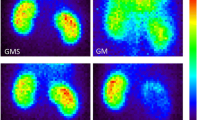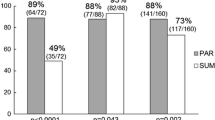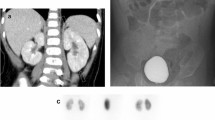Abstract
The use of99mtechnetium dimercaptosuccinic acid (99mTc-DMSA) scintigraphy for the early diagnosis of pyelonephritis has been evaluated in a study performed on adolescent female Sprague-Dawley rats exposed to an ascendingEscherichia coli infection. The rats were studied with DMSA scintigraphy either before and 5 days after the infection or 5 and 28 days after the infection. One group of rats received anti-microbial treatment during days 6–11. After the last DMSA scintigraphy the rats were sacrificed and the kidneys prepared for light microscopy study. Kidney morphology was normal and DMSA uptake was high and homogeneous in all control rats. The majority of the rats exposed toE. coli developed inflammatory changes, on light microscopy which extended to various degrees in the renal parenchyma. Five days after the infection the DMSA uptake was consistently reduced, if the inflammatory lesion on light microscopy involved more than 15% of the renal cortex. Twenty-eight days after infection the inflammatory changes were less extensive than at 5 days. The DMSA uptake had usually improved. At this time, however, areas of decreased DMSA uptake could be detected even if the light microscopy changes involved less than 15% of the parenchyma. Microscopical lesions were less frequent and less extensive in the treated than in the untreated rats. The complete return to normal of previously abnormal DMSA uptake was only observed in treated rats. In a few untreated rats cortical scars had formed by day 28. The scars appeared in areas with decreased DMSA uptake at 5 days. The results imply that DMSA scintigraphy is a valuable method for the early diagnosis and for the localization of pyelonephritis.
Similar content being viewed by others
References
Hodson CJ, Edwards D (1960) Chronic pyelonephritis and vesicoureteric reflux. Clin Radiol 11: 219–231
Huland H, Busch R (1984) Pyelonephritic scarring in 213 patients with upper and lower urinary tract infections. Long-term follow-up. J Urol 132: 936–939
Smellie J, Edwards D, Hunter N, Normand ICS, Prescod N (1975) Vesico-ureteric reflux and renal scarring. Kidney Int [Suppl]8: 65–72
Wikstad I, Aperia A, Broberger O, Ekengren K (1979) Vesicoureteric reflux and pyelonephritis. Long time effect on area of renal parenchyma. Acta Radiol Diagn 20: 252–259
Jodal U, Lindberg U, Lincoln K (1975) Level diagnosis of symptomatic urinary tract infections in childhood. Acta Paediatr Scand 64: 201–208
Pylkkänen J, Koskimies O, Vilska J (1984) Natural history of symptomatic urinary tract infection in childhood. In: Brodehl K, Ehrich J (eds) Paediatric nephrology. Springer, Berlin Heidelberg New York, pp 298–301
Enlander D, Weber P, Remedios L dos (1974) Renal cortical imaging in 35 patients: superior quality with 99m-Tc-DMSA. J Nucl Med 15: 743–749
Stoller ML, Kogan BA (1986) Sensitivity of 99m-technetium-dimercaptosuccinic acid for the diagnosis of chronic pyelonephritis: clinical and theoretical considerations. J Urol 135: 977–980
Hannerz L, Celsi G, Eklöf A-C, Olling S, Wikstad I, Aperia A (1989) Ascending pyelonephritis in young rats retards kidney growth. Kidney Int 35: 1133–1137
Hannerz L, Wikstad I, Broberger O, Aperia A (1983) Influence of diuresis on the degree of vesicoureteral reflux. An experimental investigation in rats. Acta Radiol Diagn 24: 395–399
Larsson P, Kaijser B, Mattsby-Baltzer I, Olling S (1980) An experimental model for ascending acute pyelonephritis caused by Escherichia coli or proteus in rats. J Clin Pathol 33: 408–412
Handmaker H (1982) Nuclear renal imaging in acute pyelonephritis. Semin Nucl Med 12: 246–253
Conway J (1984) Radionuclide imaging of acute bacterial nephritis. Contrib Nephrol 39: 28–35
Mendez G, Morillo G, Alonso M, Isikoff M (1980) Gallium-67 radionuclide imaging in acute pyelonephritis. Am J Roentgenol 134: 17–22
Sty J, Wells R, Starshak R, Schroeder B (1987) Imaging in acute renal infection in children. Am J Roentgenol 148: 471–477
Smellie JM, Shaw PJ, Prescod NP, Bantock HM (1988) 99m-Tc dimercaptosuccinic acid (DMSA) scan in patients with established radiological renal scarring. Arch Dis Child 63: 1315–1319
Smellie JM, (1989) Host parasite interactions. In: Kass EH, Svanborg E (eds) Urinary tract infections. University of Chicago Press, Chicago, pp 258–264
Author information
Authors and Affiliations
Rights and permissions
About this article
Cite this article
Wikstad, I., Hannerz, L., Karlsson, A. et al. 99mTechnetium dimercaptosuccinic acid scintigraphy in the diagnosis of acute pyelonephritis in rats. Pediatr Nephrol 4, 331–334 (1990). https://doi.org/10.1007/BF00862511
Received:
Revised:
Accepted:
Issue Date:
DOI: https://doi.org/10.1007/BF00862511




